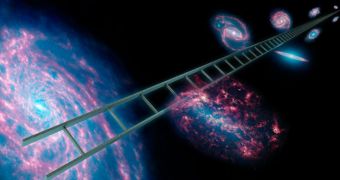A group of experts operating the NASA Spitzer Space Telescope announce that they were able to refine the value attributed to the Hubble constant with the greatest degree of precision ever achieved.
In a nutshell, Hubble's constant refers to the speed at which the Universe is expanding, under the influence of dark energy. Current values indicate that the entire firmament is moving away from its point of origin, where the Big Bang occurred, at ever-increasing speeds.
The constant is the factor by which this speed increases, and represents a piece of data that is absolutely essential for modeling the future evolution, and the ultimate fate, of the Cosmos. Researchers are now getting very close to pinpointing its exact value, thanks to the new effort.
In the 1920s, Edwin P. Hubble, for whom the famous NASA telescope is named, demonstrated that the Universe has been continuously expanding since it first rapidly expanding into being, more than 13.75 billion years ago.
A little more than a decade ago, astronomers determined that this expansion was accelerating in time.
The new Spitzer study improves the accuracy of previous measurements on the Hubble constant by a factor of 3. Previously, the most precise value was determined by the NASA Hubble Space Telescope, which surveys the Universe at wavelengths ranging from near-infrared, through optical, to ultraviolet.
Spitzer sees long-wavelength infrared light, and is therefore better suited for conducting this type of research. The uncertainty level related to the value of Hubble's constant has now been decreased to just 3 percent, researchers are proud to announce.
“The newly refined value for the Hubble constant is 74.3 plus or minus 2.1 kilometers per second per megaparsec. A megaparsec is roughly 3 million light-years,” NASA announced yesterday, October 3.
“Spitzer is yet again doing science beyond what it was designed to do. First, Spitzer surprised us with its pioneering ability to study exoplanet atmospheres, and now, in the mission's later years, it has become a valuable cosmology tool,” says Michael Werner.
The expert holds an appointment as a Spitzer project scientist at the NASA Jet Propulsion Laboratory (JPL) in Pasadena, California, and has been involved in this mission since the infrared telescope was in its early concept phase, more than three decades ago.
In addition to providing this much-needed measurement refinement, the telescope also enabled scientists to obtain an independent measurement of dark energy. This was achieved by combining Spitzer data with information collected by the NASA Wilkinson Microwave Anisotropy Probe.
WMAP is studying the relic radiation left behind by the Big Bang, called the Cosmic Microwave Background (CMB).

 14 DAY TRIAL //
14 DAY TRIAL //